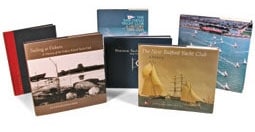
Club History Books
Each half model, black-and-white photo, or engraved trophy in the halls of our sailing institutions has a story to tell. At first, these stories pass along naturally, but over time, at older clubs, there’s a logical impulse to create a record of the old yachts, commodores, and past events. In recent years, this has led to publication of more and more club history books. We published one last year at the Fishers Island YC (N.Y.), and it was a daunting yet rewarding, four-year project. We not only explored our history, but learned to see today’s club through a different lens. And we learned a lot about writing this kind of a book. Funding can come from member dues, but “patrons” typically chip in, as 391 members did at St. Francis YC (in San Francisco) to help pay for their 1927-2002 project. What defines this type of book, however, is a good, willing history committee, and a lead editor or writer who will doggedly seek out photographs, letters, newsletters, yearbooks, and other club records. The New Bedford YC (Mass.) had the combination of excellent archival info and a member, Llewellyn Howland III, with the patience and fortitude to write a year-by-year account of 125 years. The San Diego YC had good photos and dozens of champions to profile for its 1886-2000 book, but also found lots of good newspaper clippings and sidebar topics to vary the pace. The Noroton YC (Conn.), as befits its casual nature, used a series of essays and profiles written by past commodores and other members, and included the unique cartoon illustrations of member Peter Wells. Lake Hopatcong YC (N.J.), whose book arrived as I was writing this, worked with a local museum, which helped them tell most of their story through photos. Many clubs hire a professional writer, which in our case not only meant the job would get done, but also in much finer fashion. John Rousmaniere’s early research showed us FIYC was founded in 1928, not 1886, and he quickly convinced us to broaden our focus; much of the finished product reviews activities that took place before the FIYC existed. He also encouraged us to take on Mystic Seaport Museum as co-publisher, which made Rosenfeld photos of famous power and sailboats available, plus a professional editor and quality designer. If you can’t shake the impulse to do a club history, my advice is to get started. Top priorities are oral histories with older members and the collection of good photos. The project will take longer than you expect and develop a life of its own, leading you down fascinating pathways. If your outfit is like the New York YC, founded in 1844, there will be multiple histories to write; fortunately, you only have to work on one at a time.









